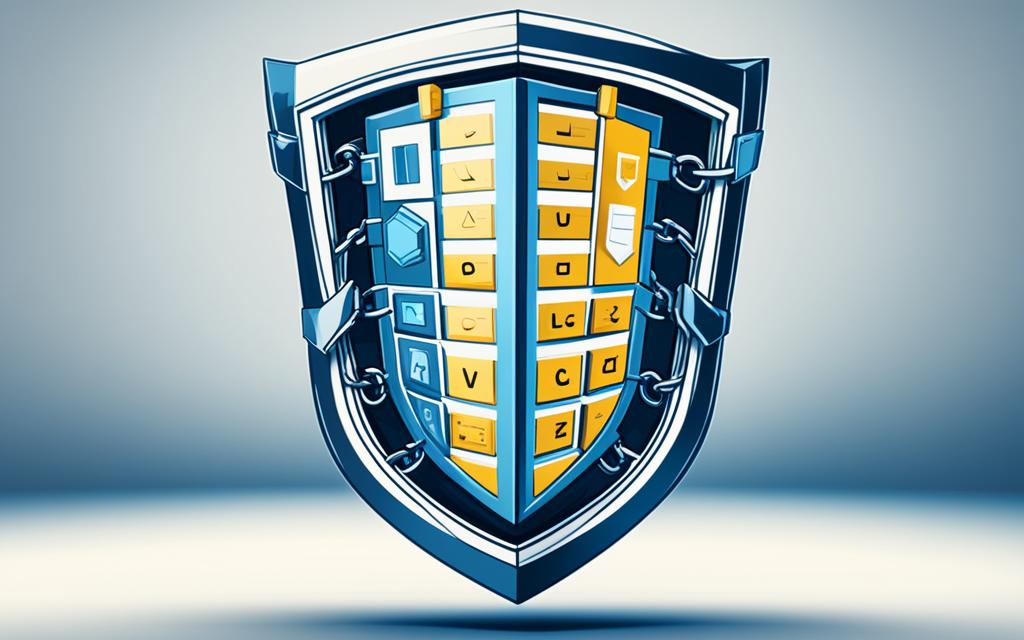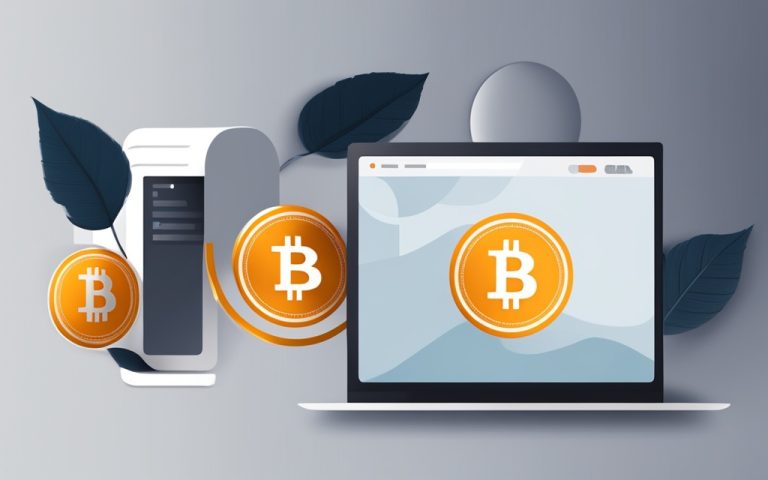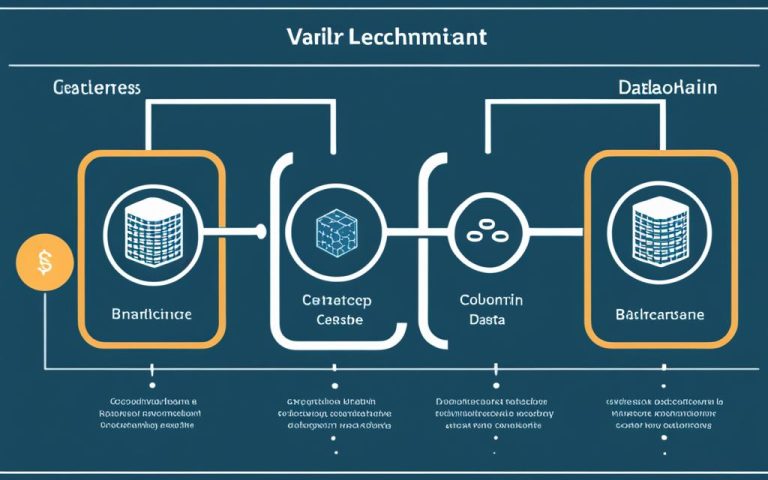In today’s world, keeping information safe while sharing it is a big challenge. Blockchain technology offers a promising solution. It gives a way to share data securely, bringing in trust and transparency.
Blockchain uses special cryptography, and a network spread out across many places to keep shared data safe and unchanged. It uses a unique kind of cryptography to make sure the data stays intact, letting anyone check the data’s validity.
Proof of Stake (PoS) and Proof of Work (PoW) are methods used to check data transactions. They make sure that only valid transactions are added to the blockchain. This keeps the data safe and stops any unauthorized changes.
The way blockchain is built adds more security. Once data is part of a block in the chain, changing it is nearly impossible without being noticed.
Data encryption is key in blockchain. It uses public-key cryptography and digital signatures to keep information secret. Only those allowed can access it.
Blockchains make data sharing clear and straightforward by cutting out the middleman. This helps everyone involved share data easily and directly.
Blockchain also allows for tracking the history of shared data. This is great for industries like healthcare where tracking patient records accurately is vital.
Digital signatures and contracts built into the system make sure data is real and agreements are followed. This brings trust and cuts down the need for checking everything manually.
Big names like IBM, UNICEf, and Walmart are now using blockchain for safer and clearer data sharing.
Looking ahead, blockchain will likely see exciting developments. We might see hybrids of public and private blockchains, offering more flexibility in how data is shared.
Combining artificial intelligence (AI) with blockchain could further improve security. AI could help spot and fix security issues before they become a problem, making data sharing even safer.
In summary, blockchain technology is changing the way we share data, making it more secure, clear, and efficient. By adopting blockchain, organizations can protect their data, ensure it remains correct, and make sharing easier.
For more information on data-sharing in blockchain technology, please refer to the following resources:
- Data Sharing: A Blockchain Approach
- Which Statement Describes Data Sharing in a Blockchain
- Blockchain-Based Systematic Medical Data Sharing and
How Does Blockchain Enhance Data Security in Data Sharing?
Blockchain technology changes how we keep data safe when sharing it. It uses cryptographic hashes and consensus methods for top-notch protection. This way, sensitive info is kept secure.
Cryptographic hashes ensure that the data on a blockchain stays true. These digital IDs act as a seal that’s hard to break. By checking the hash against the original, anyone can confirm if the data is real or has been changed.
Consensus mechanisms like Proof-of-Stake (PoS) and Proof-of-Work (PoW) bump up security. They check and confirm transactions, blocking unapproved changes. With a network of users agreeing, only the right data gets on the blockchain.
Blockchain makes every piece of data traceable through a chain of blocks. Each block links to the one before it. This setup stops data from being altered or accessed without permission.
Data encryption also plays a big role in keeping things safe. Blockchain uses special cryptography so only certain people can see the data. A private key for the owner, and a public one for others, keep shared data secure.
Digital signatures add another level of safety and proof in sharing data. They use unique algorithms to check who sends and owns the data. This ensures the data’s purity and source.
In short, blockchain gives a trustworthy and secure way for sharing data. Companies can be sure their info is safe, cutting down on unauthorized access and breaches. Blockchain’s smart tools like hashes, consensus, and encryption build a trusty environment for data sharing.
Table: Comparison of Data Security Measures in Traditional Systems and Blockchain-based Data Sharing
| Data Security Measures | Traditional Systems | Blockchain-based Data Sharing |
|---|---|---|
| Data Integrity | Prone to tampering and alteration | Immutable due to cryptographic hashes |
| Authorization | Centralized control, susceptible to unauthorized access | Decentralized network, user authentication through digital signatures |
| Data Privacy | Risk of data breaches and privacy violations | Protected through encryption and public-key cryptography |
| Auditing and Transparency | Limited visibility and difficulty in traceability | Transparent record of all data transactions |
Current and Future Trends in Blockchain-Based Data Sharing
Blockchain technology is getting better all the time. It’s leading to new trends in the way we share data. These trends make things more secure and offer new ways for different industries to use the technology.
Hybrid Blockchains: A big trend is hybrid blockchains. They mix the best parts of private and public blockchains. This way, they can handle more data, keep data private, and let people control data sharing better.
AI Integration: Also, Artificial Intelligence (AI) is being combined with blockchain. AI and machine learning help automate and improve data analysis in blockchain networks. This makes data sharing more efficient and accurate.
Many industries are checking out blockchain for sharing data. Fields like supply chain, healthcare, and finance are using blockchain to get better at sharing data.
To keep up with the latest, organizations should keep an eye on new studies and articles. Useful resources include Investopedia’s article on Blockchain, a research paper on blockchain-based data sharing, and a study on blockchain technology.
The Promise of Future Advancements
The future of sharing data with blockchain looks very promising. It’s likely to bring even more improvements and new ideas. Blockchain will keep changing how we share data in many industries.
Getting blockchain to work faster is one goal. Making blockchain networks faster will make sharing data quicker and more effective. People are finding ways to solve these speed issues to fit blockchain better into current systems.
Also, new research into keeping data private will change data sharing. Tools like proxy re-encryption and attribute-based encryption will make cloud data sharing much safer and private.
It’s important for companies to follow these trends and get ready for what’s coming. By using hybrid blockchains, adding AI, and staying informed, businesses can be leaders in data sharing.
| Trend | Benefits |
|---|---|
| Hybrid Blockchains | Scalability, data privacy, enhanced control |
| AI Integration | Automated data analysis, improved decision-making |
| Improved Scalability | Faster and more efficient data sharing |
| Privacy-Preserving Techniques | Enhanced security and privacy in data sharing |
In conclusion, the field of blockchain-based data sharing is always changing and full of opportunities. By getting into trends like hybrid blockchains and AI, and looking forward to new developments, companies can really benefit from blockchain in sharing data.
Conclusion
Data sharing is very important for businesses. It helps with teamwork, making decisions, and creating new things. Blockchain is important here because it makes sharing data safe and open.
Big names like IBM, UNICEF, and Walmart are already using blockchain. It has made sharing data better, easier to see, and easier to track. But, it’s important to solve some problems related to using blockchain for sharing data.
In the future, combining blockchain with AI will change how we share data. This will make blockchain even more useful. It will help businesses share data better, work more efficiently, and keep up with new technology.
FAQ
Why is data-sharing important in organizations?
Data-sharing helps teams work together better. It supports making smart choices. It also sparks new ideas.
How does blockchain enhance data security in data sharing?
Blockchain technology makes data safe by using special codes and group approval. This stops data from being changed without permission.
What are some current and future trends in blockchain-based data sharing?
Right now, hybrid Blockchains are popular. They mix private and public types. Teams are also using AI to handle data better.
Looking ahead, we expect even cooler blockchain innovations. These will make data sharing more advanced.
How can organizations tap into the benefits of blockchain technology for data sharing?
Companies can use blockchain to share data better. It makes data-sharing safe and open. It helps improve how they work.



















